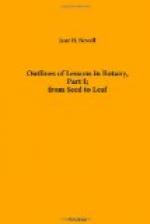1. Study of the Roots of Seedlings.—One or two of the seedlings should be broken off and the slips put into a glass of water. They will be studied later. Bean and Sunflower are the best for the purpose.
Begin by telling the pupils to prepare for their first lesson a description of the roots of their seedlings. Those grown on sponge or paper will show the development of the root-hairs, while those grown on sand are better for studying the form of the root. Give them also some fleshy root to describe, as a carrot, or a radish; and a spray of English Ivy, as an example of aerial roots.
Throughout these lessons, the method is pursued of giving pupils specimens to observe and describe before teaching them botanical terms. It is better for them to name the things they see than to find examples for terms already learned. In the first case, they feel the difficulty of expressing themselves and are glad to have the want of exact terms supplied. This method is discouraging at first, especially to the younger ones; but, with time and patience, they will gradually become accustomed to describe whatever they can see. They have, at any rate, used their eyes; and, though they may not understand the real meaning of anything they have seen, they are prepared to discuss the subject intelligently when they come together in the class. If they will first write out their unassisted impressions and, subsequently, an account of the same thing after they have had a recitation upon it, they will be sure to gain something in the power of observation and clear expression. It cannot be too strongly urged that the number of facts that the children may learn is not of the slightest consequence, but that the teacher should aim to cultivate the quick eye, the ready hand, and the clear reason.
The root of the Morning-Glory is primary; it is a direct downward growth from the tip of the caulicle. It is about as thick as the stem, tapers towards the end, and has short and fibrous branches. In some plants the root keeps on growing and makes a tap-root; in the Bean, it soon becomes lost in the branches. These are all simple, that is, there is but one primary root. Sometimes there are several or many, and the root is then said to be multiple. The Pumpkin is an example of this. The root of the Pea is described in the older editions of Gray’s Lessons as being multiple, but it is generally simple. Indian Corn, also, usually starts with a single root, but this does not make a tap-root, and is soon followed by many others from any part of the caulicle, or even from the stem above, giving it the appearance of having a multiple root.
The root of the Radish is different from any of these; it is fleshy. Often, it tapers suddenly at the bottom into a root like that of the Morning-Glory with some fibres upon it. It is, in fact, as the Morning-Glory would be if the main root were to be thickened up by food being stored in it. It is a primary tap-root. The radish is spindle-shaped, tapering at top and bottom, the carrot is conical, the turnip is called napiform; some radishes are shaped like the turnip.




